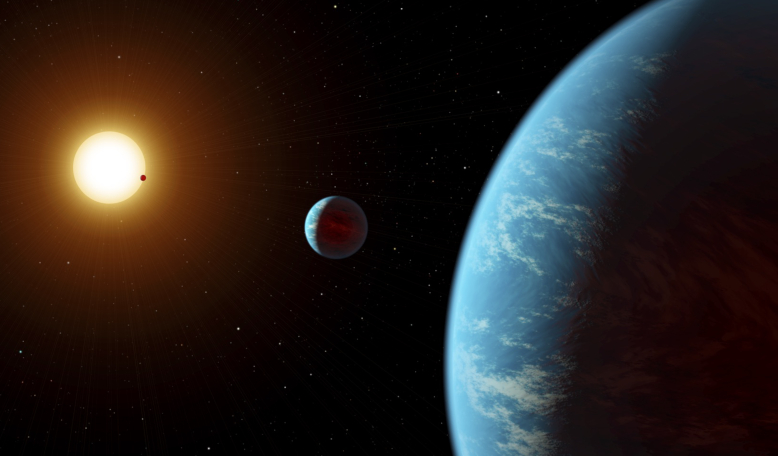A true water-filled world that could contain as much as 80 times more water than Earth and has an ocean hundreds of kilometres deep has been identified by a team of astronomers in a planetary system 40 lights years (10.5 parsecs) away.
A few years ago, scientists using HARPS (the High Accuracy Radial velocity Planet Searcher) - an instrument dedicated to the discovery of extrasolar planets and the now retired Spitzer Space telescope, discovered LHS 1140; a cool dwarf star with a surface temperature around 2400-3700 Kelvin that hosted two planets, LHS1140c and LHS1140b.
Studies on the system indicated that both planets had rocky compositions and while the inner planet, LHS1140c was found to whizz around its host star in just 3.8 days, LHS1140b, turned out to be a super-Earth with an orbital period of around 24 days, placing it just inside the habitable zone.
LHS1140b’s characteristics and location within a region where it could potentially have liquid water on its surface, flagged it up as a key target for further astrobiological research.
Taking a keen interest in the system, scientists at the Remote Worlds Lab and Laboratoire d’Astrophysique de Marseille in France, set to work on collecting further data on the system with the aid of ESO’s planet hunting spectrograph, ESPRESSO (Echelle SPectrograph for Rocky Exoplanets and Stable Spectroscopic Observations).
The team, headed by Jorge Lillo-Box at the Centro de Astrobiología in Madrid, Spain, collected 113 new high-precision radial velocity observations over a year and half, doubling the amount of data first obtained with HARPS.
After performing an extensive analysis of the two datasets (HARPS and ESPRESSO), the team also examined new TESS photometry data on the two planets, which had captured four new transits of LHS1140c and one new transit of LHS1140b.
Coupled with several computer simulation of planets and orbital configurations, the team were able to discern that the inner planet, LHS1140c, is not only less massive but it also has a huge core twice that of Earth (Earth’s core makes up 32 percent of its overall mass), with an additional 40 percent of its mass stored in the mantle.
LHS1140b on the other hand is half core and half mantle. But the biggest difference between the two is the water content.
Although oceans cover 71 percent of the Earth's surface, they only account for 0.02 percent of our planet's total mass.
For LHS1140c, less than 0.006 percent of its mass is due to water; a figure to be expected from this short-period planet sayss Lillo-Box and colleagues.
But, for super-Earth LHS1140b, mass/radius calculations suggest that a staggering four percent of the planet’s mass is water, which could equate to a deep ocean layer of 779 (± 650) kilometres, write the team in their research paper published recently in Astronomy and Astrophysics journal.
“The datasets have allowed us to determine the properties of these two planets with unprecedented precision,” says lead author Lillo-Box.
Fans of the sci-fi blockbuster Interstellar might recall that the first planet Matthew McConaughey and fellow astronauts visit is a seemingly benign planet with no discernible features except for lots of water and a far-off high mountain range. Those mountains turn out out a 1.2 kilometre (4,000 foot) high wave caused by the planet's proximity to Gargantua, the black hole featured in the film.
Aside from a colossal wall of water that devastates anything in its path, could LHS1140b also be classed as a water-world in another planetary system? The evidence we have says so, Lillo-Box says on the Lab’s YouTube page.
The intrigue behind the LHS1140 system doesn't stop there as interestingly, the radial velocities also suggest the presence of a third planet in the system, right beyond the habitable zone with a 79 day period, adds Lillo-Box.
However, although the detection of the signal is clear, says the author, the three planet model doesn’t quite fit with the current data. And unfortunately the transits of this planet candidate, which is on the border between that of a super-Earth and a mini-Neptune, will not be visible in the re-observation of this star in TESS cycle 3.
In addition, the team suggest that the inner-most planet might also be sharing an orbit with another planet; a phenomena known as co-orbital worlds.
In astronomy, a co-orbital configuration is a configuration of two or more astronomical objects (such as moons or planets) trapped in gravitationally stable regions.
Lillo-Box and colleagues research indicated that although there was no evidence for co-orbital worlds around LHS1140b, there were signs of one around its smaller neighbour LHS1140c at its Lagrange point L4. Lagrange Points are positions in space where the gravitational forces of a two body system produce enhanced regions of attraction and repulsion.
This was backed up with TESS data that showed a dimming in the light curve for the planet at this exact position, adding additional hints at the presence of an orbit-sharing planet.
If LHS1140c does turn out to have a co-orbital companion this would also be a first, as although co-orbital planets have been theorised, none so far have been discovered.











